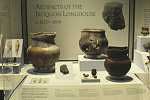
|
The artifacts of stone, antler, bone and fired clay that you
will see in these slides are thought to be 400 to 550 years old.
Some of the slides are closer views of objects in this display.
Iroquois clay pots in Artifacts of the
Iroquois Longhouse, c.1450-1600, A Mohawk Iroquois Village.
New York State Museum, Albany, NY. |
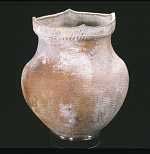
|
An intact clay pot is a rare find for archeologists. The most
common artifacts they find are fragments of clay pots called "sherds."
Intact Iroquois clay pot, c.1450-1500, found in
a rock shelter. Jefferson County, NY. Height: 14 inches |
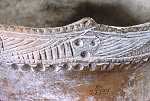
|
Iroquois potters were women. They frequently decorated the
pots around the rim; here we see a simple human face.
Detail view of the intact pot, showing a
simplified human face within a decoration of repetitive lines on
the rim. |

|
Iroquois pots had rounded bottoms, as shown here in another
intact example found in a rock shelter. In use, they were
suspended over a fire, or put in the fire and propped up with
rocks placed around the bottom. That shiny object at the base of
the pot is a ring stand that holds it upright in the exhibit.
Intact Mohawk Iroquois clay pot, c.1550-1600,
found in a rock shelter. Hamilton County, NY. Height: 10 inches. |
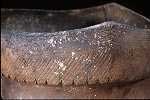
|
Detail view of typical incised decoration on the collar of the
pot, made by incising the design into the moist clay with a wood,
bone, or antler tool. Sometimes the potter made decorations with
her fingernails. Intact Mohawk Iroquois clay
pot, c.1550-1600, found in a rock shelter. Hamilton County, NY.
Height: 10 inches. |

|
Although sherds from a broken pot will last indefinitely when
buried in the ground, the clay pot itself was fragile and easily
cracked during use. This broken pot was put back together again by
an archeologist. Reconstructed Mohawk Iroquois
clay pot, c.1550-1575, excavated on the Klock site, Fulton County,
NY. Height: 11 inches. |
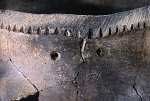
|
A close look at this pot shows that before it broke completely
and was thrown out, it had cracked. Its owner attempted to repair
it by drilling holes on either side of the crack to tie it
together. Detail view of the reconstructed pot,
showing the lashing holes drilled to either side of crack in an
attempt to repair the pot. |
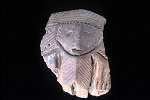
|
The meaning of human effigies, sometimes found along the rims
of Iroquois pots, is unknown; rarely are they as big and boldly
made as this example. Human effigy decoration
from below the rim castellation of a large Mohawk Iroquois clay
pot, c.1575-1600. Fulton County, NY. Height: 4 inches. |
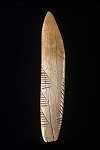
|
Decorations on clay pots were most commonly made by incising,
or scratching the design into the surface of the clay, before the
pot was baked in a fire. The potter used the pointed end of a bone
tool like the one shown here. Iroquois bone
pottery incising tool, c.1500-1550. The sides of the pointed upper
end have been worn flat by grit in the clay. Notice the incised
decorations on the tool which resemble those found on some clay
pots. Height: 3 ¾ inches. Jefferson County, NY. |
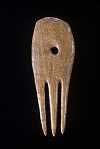
|
Bone and antler objects, such as this antler comb, are not
frequently preserved on an Iroquois village site because the
material disintegrates when buried in acidic soil.
Oneida Iroquois antler comb, c.1500-1550. Early Iroquois combs
had few teeth, usually three to four, unlike those carved after
the introduction of European metal tools in the late 1500s.
Height: 3 ¾ inches. Madison County, NY. |
| |
http://www.nysm.nysed.gov/IroquoisVillage/slidetwoa.html |
|
 ClayHound Web
- IROQUOIS
Pottery
ClayHound Web
- IROQUOIS
Pottery ClayHound Web
- IROQUOIS
Pottery
ClayHound Web
- IROQUOIS
Pottery